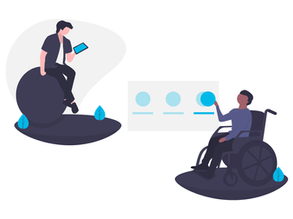Diversity and inclusion are increasingly at the centre of our cultural conversation. This conversation is happening not only in the streets, but also in the halls and boardrooms of businesses across the world. For successful organizations, diversity and inclusivity are not simple boxes to check but core components of their culture that increase employee engagement and improve their bottom line. Organizations that actively cultivate and support an inclusive work environment see more employees reach their potential and improved overall performance.
What Diversity and Inclusion Mean in the Workplace
With each new graduating class, the diversity of the workforce is growing. This can make it tempting to believe that diversity and inclusivity are inevitabilities that will take care of themselves with time. However, fostering them as part of an organization’s culture means actively identifying the intersections where ethnicity, gender, age, and other identities cross and asserting their value and equality. Simply having a diverse group of employees does not guarantee an inclusive culture and the benefits that it provides.
Benefits of an Inclusive Culture
Beyond intangible benefits to a company’s reputation and credibility in the realm of corporate social responsibility, there are measurable impacts that an inclusive culture can deliver. Perhaps most notably, research shows that companies with more diverse management teams make more money. Additionally, diverse workforces have been shown to be more innovative and better able to capture new market share.
On an individual level, employee engagement is markedly improved when employees feel their workplace actively promotes an inclusive culture, especially among millennials. Employee retention is also strongly supported by a culture that is not only diverse but takes steps to affirm the value of different identities.
How to Actively Build a Diverse and Inclusive Work Culture
Review Onboarding from the Ground Up
Beyond hiring a diverse group from the candidates you interview, create a more diverse pool of candidates to begin with. Reach out to job boards in minority communities and target internships at underrepresented groups to access talent that would otherwise be missed. Ensure you also have a diverse panel reviewing the applications.
Reconsider Existing Policies and Benefits
Examine existing policies to consider if they are fair for everyone. Consider how things like leave policies, core work hours, or health benefits could be adjusted for different groups. Single parents, staff living with a disability, different religious groups and others may all be silently making do under the current structure and having their performance impacted. Small changes may yield big results and have a significant impact on morale and engagement.
Implement a Training Program
Offer diversity training programs that highlight issues of unconscious bias and how to address diversity, beginning with managers. Beyond the benefits of the training content, this creates a dedicated time and space where team members can feel comfortable to discuss issues around diversity and inclusivity. Starting the conversation is an invaluable first step.
Enlist the Support of Leaders and Culture Makers
To achieve employee buy-in and nurture this cultural transformation, it is critical that leadership and employee culture makers actively advocate and model inclusivity. Employee culture makers are the natural socializers and leaders in the workforce that are in tune with employee engagement. Along with managers, it is key that they speak up and promote the value of these initiatives.
Create Employee Led Taskforces and Events
Employees and managers may not always feel comfortable discussing issues around diversity and inclusivity. An interdepartmental panel, comprised of a diverse group of managers and staff, should be created to act as a neutral forum for respectfully discussing these issues. On a lighter note, this panel can also act as an event planning committee. They can bring staff together to celebrate different holidays and organize social events under the umbrella of diversity.
Where to Begin
Culture can be a difficult thing to nail down, and efforts to build diversity and inclusivity into an organization’s culture must be continuous. On the plus side, the benefits they create are substantial. Prioritizing a culture that respects and values individual identities leads to improved employee engagement, better retention, and more success as an organization.
Implementing a Diversity and Inclusion Survey can help organizations understand team members’ perceptions of where the culture stands and what direction it needs to move in.

